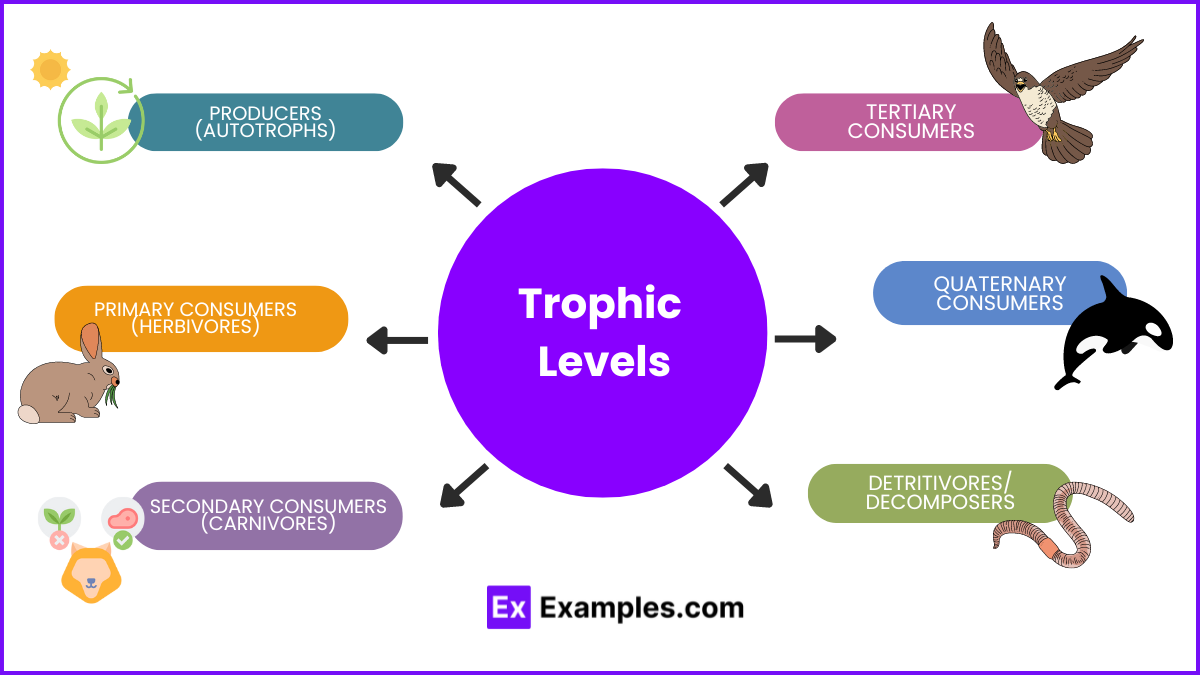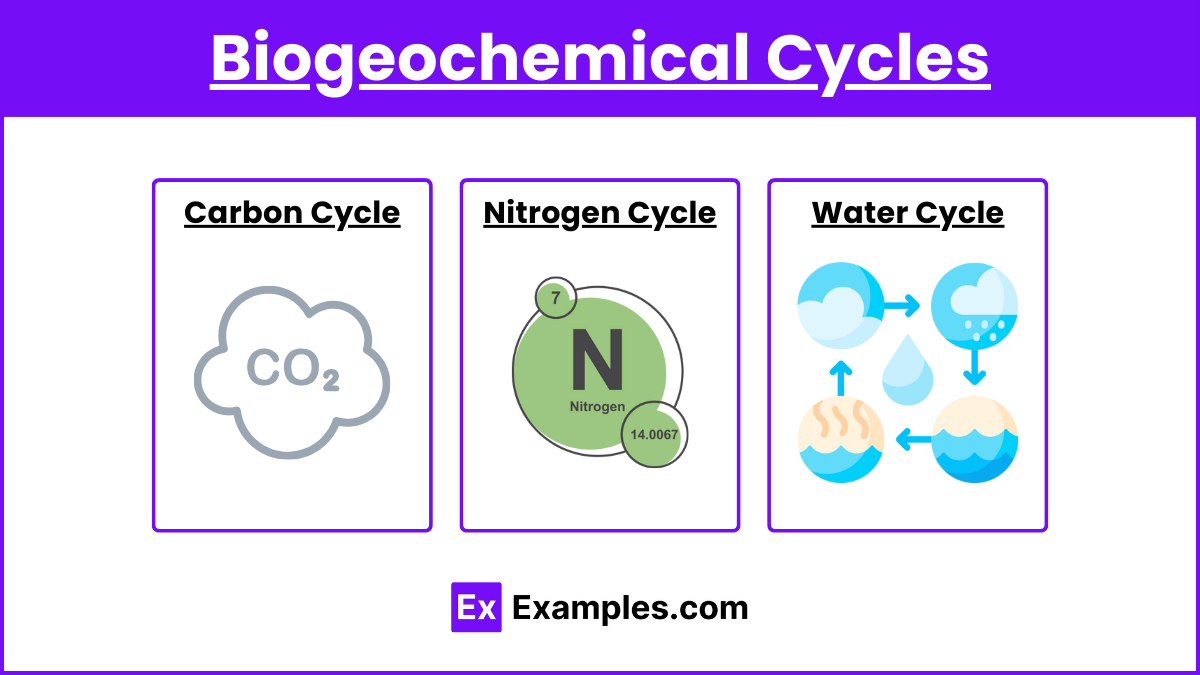In the AP Biology exam, understanding energy flow within and across ecosystems is crucial. This topic covers how energy is transferred through trophic levels, from producers to various consumers, and the efficiency of these transfers. Key concepts include the 10% rule, primary productivity (GPP and NPP), and the structure of food chains and food webs. Additionally, biogeochemical cycles, such as the carbon and nitrogen cycles, illustrate the movement and recycling of nutrients, essential for maintaining ecosystem stability and function.
Learning Objective
By studying energy flow within and across ecosystems, you will learn how energy is transferred through trophic levels, from producers to various consumers. You will understand concepts such as the 10% rule, gross and net primary productivity, and the structure of food chains and food webs. Additionally, you will explore biogeochemical cycles like the carbon and nitrogen cycles, gaining insight into how nutrients are recycled and how these processes maintain ecosystem stability and function.
Trophic Levels

- Producers (Autotrophs): Organisms that produce their own food through photosynthesis or chemosynthesis, forming the base of the food chain (e.g., plants, algae).
- Primary Consumers (Herbivores): Organisms that consume producers (e.g., deer, caterpillars).
- Secondary Consumers (Carnivores): Organisms that consume primary consumers (e.g., wolves, frogs).
- Tertiary Consumers: Organisms that consume secondary consumers (e.g., hawks, sharks).
- Quaternary Consumers: Top predators that consume tertiary consumers (e.g., orcas, eagles).
- Detritivores/Decomposers: Organisms that break down dead organic material, recycling nutrients back into the ecosystem (e.g., fungi, bacteria).
Energy Transfer Efficiency

- 10% Rule: On average, only about 10% of the energy at one trophic level is transferred to the next trophic level. The rest is lost as heat through metabolic processes.
- Energy Pyramid: A graphical representation showing the energy available at each trophic level. Producers form the broad base, with decreasing energy levels as you move up the pyramid.
Primary Productivity

- Gross Primary Productivity (GPP): The total amount of energy captured by producers through photosynthesis.
- Net Primary Productivity (NPP): The energy that remains after producers have used some for their own respiration; it is available for consumers. NPP = GPP – Respiration.
Food Chains and Food Webs

- Food Chain: A linear sequence of organisms through which energy is transferred.
- Food Web: A complex network of interconnected food chains, showing the multiple pathways through which energy flows in an ecosystem.
Biogeochemical Cycles

- Carbon Cycle: The movement of carbon through the atmosphere, biosphere, oceans, and geosphere.
- Nitrogen Cycle: The movement of nitrogen through the atmosphere, soil, and living organisms.
- Water Cycle: The continuous movement of water through evaporation, condensation, precipitation, and runoff.
Examples
Example 1: Grassland Ecosystem
- Description: Grass (producer) → Grasshopper (primary consumer) → Frog (secondary consumer) → Snake (tertiary consumer) → Hawk (quaternary consumer).
- Significance: Illustrates the transfer of energy through trophic levels and the role of each organism in the ecosystem.
Example 2: Marine Ecosystem
- Description: Phytoplankton (producer) → Zooplankton (primary consumer) → Small Fish (secondary consumer) → Larger Fish (tertiary consumer) → Shark (quaternary consumer).
- Significance: Demonstrates energy flow in an aquatic food web and the importance of primary producers.
Example 3: Forest Ecosystem
- Description: Trees (producer) → Deer (primary consumer) → Wolf (secondary consumer) → Decomposers (detritivores).
- Significance: Highlights the role of decomposers in recycling nutrients and maintaining ecosystem health.
Example 4: Coral Reef Ecosystem
- Description: Algae (producer) → Coral (primary consumer) → Small Fish (secondary consumer) → Barracuda (tertiary consumer).
- Significance: Shows the diversity of interactions in a complex food web.
Example 5: Agricultural Ecosystem
- Description: Corn (producer) → Cow (primary consumer) → Human (secondary consumer).
- Significance: Demonstrates human impact on energy flow and trophic dynamics in managed ecosystems.
Multiple Choice Questions
Question 1: What is the primary source of energy for producers in most ecosystems?
A. Organic matter
B. Solar energy
C. Chemical energy
D. Heat energy
Answer: B. Solar energy
Explanation: Producers, such as plants and algae, use solar energy to perform photosynthesis, converting light energy into chemical energy stored in glucose.
Question 2: In an energy pyramid, which trophic level has the most energy available?
A. Primary consumers
B. Secondary consumers
C. Producers
D. Tertiary consumers
Answer: C. Producers
Explanation: Producers form the base of the energy pyramid and have the most energy available because they capture energy directly from the sun.
Question 3: Which process describes the conversion of organic nitrogen into nitrogen gas by bacteria?
A. Nitrogen fixation
B. Nitrification
C. Ammonification
D. Denitrification
Answer: D. Denitrification
Explanation: Denitrification is the process by which bacteria convert organic nitrogen compounds back into nitrogen gas (N₂), returning it to the atmosphere.


